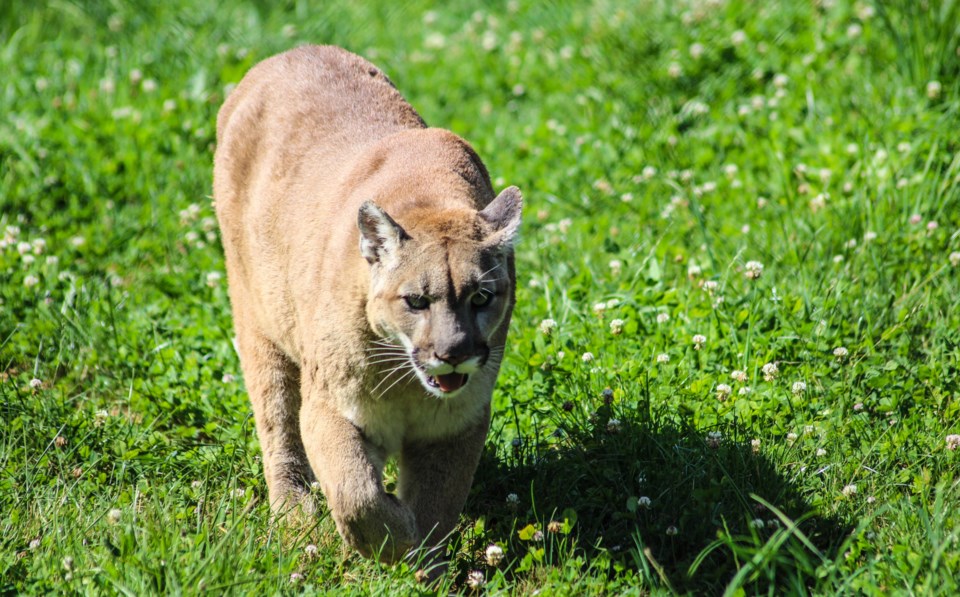—Updated: Aug. 8—
A man was attacked and injured by a cougar in Squamish on Thursday night.
This incident comes on the heels of reports of a cougar sighting in Brackendale and a cougar attack on two dogs in the Squamish Valley earlier this week.
The Conservation Officers Service says it is investigating the attack on a mountain biker that happened at approximately 6:30 p.m. on Aug. 7.
The man was mountain biking in the Alpine Capone area along Brohm Ridge when a cougar followed after him.
The public is asked to avoid the area.
"The cougar made contact and continued to follow him down the trail for approx. 20 minutes. The man, who was walking backwards holding his bike, managed to throw rocks at the cougar, which disengaged," a post to the COS social media says.
The attack was reported to the COS on Friday morning.
The COS is not actively searching for the cougar, due to the time delay and remoteness of the area where the attack happened, a spokesperson told The Squamish Chief.
Conservation officers are working with local government and the local mountain biking and outdoor associations to ensure they are aware of this incident.
The attack site is near Garibaldi Provincial Park, where aggressive cougar activity led to trail closures earlier this summer, however the agency is unable to say whether this incident is linked to the ones in Whistler.
—Original story Aug. 7—
In the wake of a warning from the Conservation Officers Service about unconfirmed cougar sightings in Brackendale and reports of a cougar attacking two dogs in the Squamish Valley over the past week, here’s how to stay safe whether you're out hiking or just minding your business at home.
It sounds exciting seeing a big cat in the wild—the biggest of the three wild cats in Canada, next to the lynx and bobcat—but it’s not wise to go looking for a cougar.
The chances are, it’ll find you first. But don’t worry, they won’t actively hunt you; they’re more interested in deer and small mammals, according to WildSafeBC.
Cougars like to “stalk an animal and then use an explosive series of bounds to leap on their prey,” WildSafeBC says on their website, and they tend to avoid areas with lots of human activity. They’re solitary animals that, like bears, don’t really want a lot to do with us insignificant humans, so encounters are pretty rare. Bear in mind, however, that in the summer, cougars are likely to seek areas close to water and with wetland cover.
How to minimize the risk of a cougar attack
This is official advice from WildSafeBC:
•Carry bear spray, and make it accessible—it’s not just for bears. And as with bears, don’t leave your garbage out. You don’t want to attract them with smells and offer them a free buffet.
•If you have children or pets, supervise them and keep them indoors, particularly at dawn and dusk when cougars are most active.
•Children may be taught how to behave if and when they see a cougar, but keep a fence around your property, and escort them outdoors—you want to be somewhere well-lit, without any dense vegetation, so the cougar has fewer places to hide.
•Furthermore, be sure to pick your children up if you’re with them and you see a cougar. Children are far easier prey with their quick movements and higher pitched voices, and you want to appear to the cougar that humans are a threat, not prey.
Speaking of which, here’s what to do if you actually encounter a cougar.
How to behave in front of a cougar
-
Above all, stay calm in front of the big cat, keep eye contact and back away slowly, leaving it a clear exit route. Do not run. You’re not playing cat and mouse.
-
Pick children or pets up immediately and move indoors, if applicable.
-
You’re not prey, so be the aggressor, and stay alert. Literally shout at the big cat, or make some loud noises, grab anything (without crouching) to readily use as a weapon. Have your bear spray ready, too. You can also make yourself appear bigger by raising and waving your arms about, for example.
-
If the cougar does decide to attack, fight it with everything you’ve got, and focus on its facial and eye area. Do not “play dead.”
-
In some situations, the cougar will make defensive vocalizations, such as hissing or growling, to tell you to keep away; it may even just be watching you to see what you’ll do.
Who to contact
Cougar encounters may occur any time of year. Unlike bears, cougars do not hibernate.
To report a wildlife conflict or a sighting, call a conservation officer via the 24-hour RAPP (Report All Poachers and Polluters) hotline on 1-877-952-7277
Stay safe!
~With files from Jennifer Thuncher/The Squamish Chief
Ina Pace is The Squamish Chief's Local Journalism Initiative (LJI) reporter.
This reporting was produced through the Local Journalism Initiative (LJI) which supports original civic journalism across Canada.



